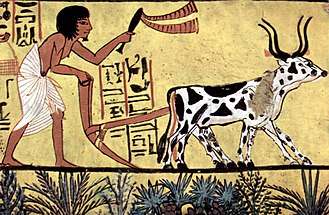Seasonal food
 |
| Agriculture |
|---|
| History |
| On land |
| In water |
| Related |
| Lists |
| Categories |
|
|
|
'Seasonal produce ' refers to the times of year when the harvest or the flavour of a given type food is at its peak. This is usually the time when the item is harvested, with some exceptions; an example being sweet potatoes which are best eaten quite a while after harvest. It also appeals to people who prefer a low carbon diet that reduces the greenhouse gas emissions resulting from food consumption (Food miles).
History
In contrast, summer diet consisted of green beans, radish, lettuces, chicories, aubergine, carrots, cucumber, gherkins, watercress, marrow, courgettes, and rice. The meat accompanied these vegetables consisted mainly of poultry, ostrich and beef products. Fruity deserts included fruits such as lemon, lime quinces, nectarines, mulberry, cherries, plums, apricot, grapes, pomegranates, watermelon, pears, apple, and melon. Meanwhile, the drinks involved syrups and jams. Fruit pastels, lemon, rose, jasmine, ginger and fennel.[1]
In Autumn, meals included cabbage, cauliflower, carrots, celery, gourd, wheat, barley, millet, turnips, parsnips, onions, acorns, peanuts, pulses, and olive oil. Drinks incorporated aromatic herbs and flower distillations of essential oils.
Gallery
References
- ↑ al-Hassani, Woodcok and Saoud (2007), 'Muslim Heritage in Our World', FSTC publishing, p.30.
External links
- BBC Good Food - Seasonality table (UK)
- BBC Food - In season section
- Seasonal food calendar (note: this site requires you to enter a New York zip code. 10003 is one that will work)
- SYUN - Japanese-English Syun 旬 Seasonal Dictionary with photo (JP)

.jpg)